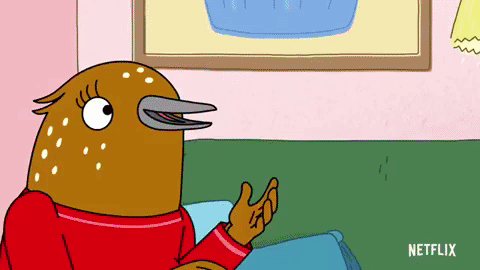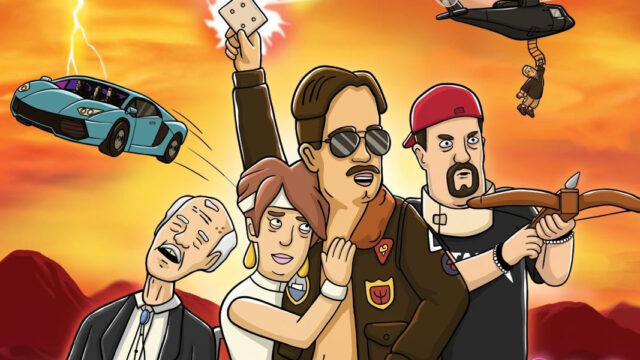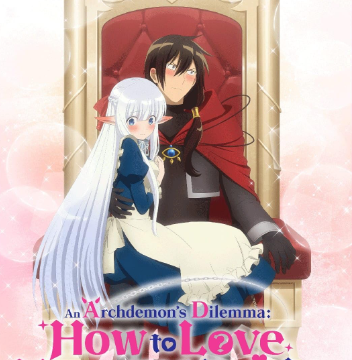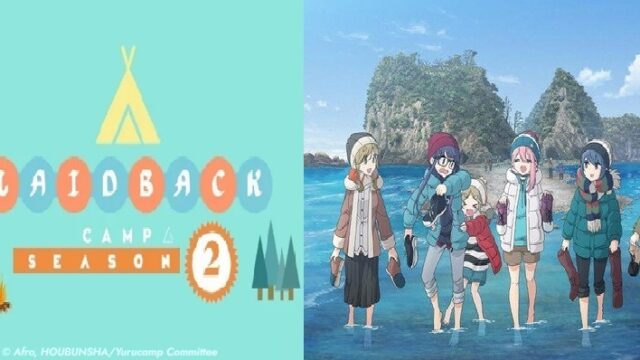Season Review: Tuca & Bertie Season One
These birds are the word. Tuca & Bertie has soared to Netflix!
Spoilers for Season 1 below!
The long-awaited creation of BoJack Horseman Production Designer, Lisa Hanawalt, has finally flown into the hearts and homes of fans everywhere. People who recognize Hanawalt’s work are still flocking to see the new, colorful, avian BFF comedy — because what’s more relatable than two bird gals chasing their dreams?
The answer? Nothing. Nothing is more relatable than this.
Tuca & Bertie is about a song thrush bird named Bertie; a mild, anxious, and responsible counterpart to her best friend Tuca — a wild, free-spirited and confident toucan. Together, they live in Bird Town: a big city full of potential feathery fun and shenanigans. As we see Tuca, Bertie, and Bertie’s adorkable boyfriend, Speckle, all navigate the throes of adulthood in their shared apartment complex, it begs the question: did Tuca & Bertie manage to navigate through the pitfalls of a typical first season? Was there anything in it that ruffled any feathers? Or was it high-flying the whole time? Will this entire review be jam-packed with bird puns that everyone has already made?
Let’s review.
Animation/Art Style
Where to begin? Hanawalt had already set the bar with her unique anthropomorphic animal character designs in BoJack Horseman — creating an iconic look that would be recognizable from any other regular cartoon animal. Her style is so definitive that anyone with eyes could take one look at Tuca & Bertie and know that it was made by her. Beyond the fun of seeing Hanawalt’s classic designs back in action, there’s the originality that sets the art in Tuca & Bertie apart from all her other creations — and on the whole, this is her best work yet.
The overall design of Tuca & Bertie really shows how well the team grasps what the art in an animated show is supposed to do. It’s a show about a toucan and a song thrush — two birds that (when combined) are tropical and vocal with intricate/bright patterns. The show is constantly hitting the viewer with eye-catching, fluid, and bombastically colorful visuals. Aside from matching colors well to tone, the art style can change at any moment to match the theme of a scene — for example, characters can be talking about architecture and suddenly be stylized in a blueprint world. From the bouncing details of the backgrounds to the nonstop beat of the forefront, Tuca & Bertie’s animation even seems to ‘bob’ to its own music. It’s a show that doesn’t forget it’s about birds. In all good cartoons, the visuals reflect what the show is — and it’s plain to see that the Tuca & Bertie art crew knows what they’re doing.
Even bigger than this, though, is the sheer variation of animation styles there is in the show. No one expects to walk into a cartoon and regularly see more than one type of animation style. Typography, arts-and-crafts, puppetry, sketch, pixel, claymation, cutout — it’s impossible to name them all without feeling like there are a few missing. All of these different types are thrown into the mix in order to make scenes more alluring, entertaining, and sometimes even emotional. It’s hard to remember the last time a show went out of its way to being so extra in its visual appeal — furthering the point that the show itself is very peacock-like; a bird of paradise, animated and made into a story.
Plot
Tuca & Bertie begins just after Speckle has moved into Bertie’s apartment — where Tuca had just moved out of. Tuca — now living in an apartment upstairs from the pair — has no choice but to face the reality of not having her dependable, tidy, and adult-passing BFF by her side 24/7. Bertie feels a similar loss by not having Tuca’s unabashed (and contagious) bravado to boost her up all the time. This doesn’t stop the pair from squaring off with their demons together, though. Tuca must overcome her recent sobriety, her fear of intimacy, her lack of family, and an inability to maintain a job/be a “real adult.” Bertie, on the other hand, deals with generalized anxiety, low self-esteem, sexual harassment, and a fear of commitment to Speckle.
These issues play out in slice-of-life scenarios over the course of ten episodes. Tuca peps Bertie up to be more confident in herself, while Bertie helps Tuca to be more self-sufficient. Tonally, the show very hyperactive — it’s genuinely funny in a good-hearted manner, and every episode guarantees a laugh. It addresses real-life issues in a fun way that keeps things lighthearted while maintaining an extremely respectful tone to the reality of those issues. When the show takes a turn into highlighting certain themes (such as sexual assault) as a plot point, it allows itself to step away from its colorful demeanor and let itself be real, without spontaneously making itself seem like a different show.
All of the experiences and conversations that Tuca and Bertie have to serve to embolden the point of the show, which is to portray an accurate depiction of real women, going through real (and unsung) things. Themes like the #MeToo Movement translate perfectly to certain events in the show, without victimizing any of its cast. While women empowerment is one of the main themes, seeing women also be depicted with dynamic and “gross” flaws is a breath of fresh air and sets a prime example of what it means to genuinely write a good female character.
Characters
Tuca is the spice of the show: the life of the party, so to speak. Her antics are simultaneously hilarious and relatable, yet there’s still more to her than what meets the eye. Even as (arguably) the most confident bird in Bird Town, the viewer can tell that Tuca struggles with a lot of self-doubt and self-image issues. Her seemingly random bouts of self-doubt/body criticism seem to stem from her emotionally manipulative aunt, whose jokes about Tuca’s appearance and ability to be a successful adult don’t seem definable as “jokes” so much as “emotional abuse.” Tuca’s problem with intimacy also may be due to the fact that everyone in her life, in one way or another, has left her — something that her aunt has threatened her with as a ghost of her future. While Tuca is unapologetically open and extroverted, it’s meant as a distraction from how closed off she is when it comes to letting people know the real her. It’s a wall that was built as a defense mechanism for when people (such as her dead mother or estranged siblings) leave her; a self-destructive, self-fulfilling prophecy. There are so many layers to Tuca in these major senses, but also in minor, unspoken ones. For example, she seems to exhibit symptoms of ADHD — which might be a fitting subject for the show to touch on, considering women are often grossly under-diagnosed for the disorder. Speculations aside, the end of the season left off on a really healthy note for her when she contacted her sister and attempted to reconnect. In the next season, it would be wonderful to see more of Tuca’s family and get an even broader version of her family’s story. Considering how lovable and fun she is, there’s nothing to do but hope for good things in Tuca’s future.
Bertie is an entirely different kind of dynamic character. Although she’s the “sensible one” of the duo, by no means does this equate to her being boring. The convictions that haunt Bertie are things that wouldn’t be thought to bother someone who seems so responsible on the outside — which is exactly what makes her character great. Aside from her obvious, “fitting” flaws of being anxious and self-conscious, Bertie struggles with unmanaged lust — for someone other than Speckle. Her tangled feelings when it comes to her desires appear to be rooted in her repressed sexual assault from when she was 12. The tragedy of this seems to be why she gravitates towards Pastry Pete’s predatory, controlling, and overtly physical behavior. When she does nothing to help Dakota while Pete preys on her, it’s plain to see that Bertie has realized her sexual assault has had long, lasting effects on who she is as a person. Bertie is truly an amazing character because while she realistically depicts the negative, long-term impacts of being a sexual assault survivor, she also represents a glowing and powerful depiction of a woman rising up from her trauma. It would be insane not to bring up the most beautiful, tear-jerking scene in the entire season, where Bertie swims to the bottom of the lake and retrieves her child-self from the water — finally freeing her to swim. When she confronts Speckle about her commitment issues and opens her own bakery (while literally sh*tting all over Pete’s life) it’s definitely satisfying. Maybe next season she can wrap up the loose end of her abandoned desk job? Who knows!
Speckle is a genuinely good and funny guy. He didn’t get a lot of development or story this season, but even so, here’s hoping he doesn’t get the shaft if Bertie can’t work through her issues.
Sound Design
The theme song is bound to be stuck in any viewer’s head after watching it — all music in the show is catchy and fun. The way they used dialogue samples and remixed them around to make certain jingles was really unique, but it’s hard not to be enthralled by the legitimate song numbers that took place in certain episodes. Seriously — how does a show manage to pull off several types of animation, successful comedy and storytelling, and still have time to whip up some song numbers!? It’s truly remarkable how talented the entire Tuca & Bertie team is.
Speaking of remarkable talent, every voice actress and voice actor in the show did an outstanding job of bringing their characters to life. Tiffany Haddish and Ali Wong seem to have as much chemistry as the characters themselves.
Did it do its genre justice?
Tuca & Bertie may be a comedy, but its dramatic elements fit in smoothly with the style of storytelling it aims to project. Usually, it can be very difficult for comedy to be the dominant element in a show with sad or serious undertones, due to the risk of said undertones not being written with respect and genuine emotion. It’s very apparent that the Tuca & Bertie team has taken the time, care, and thoughtfulness to address certain narratives while being empowering (and keeping it lightheartedly realistic) every step of the way. To those who went into the series expecting BoJack Horseman: it’s not BoJack Horseman. It’s fun, wacky, cartoony, upbeat, and in terms of art style diversity, it beats out our favorite talking horse.
This is a show for everyone who has ever felt too small at work, or too big in the mirror, or not enough in general. Tuca & Bertie is about positive vibes, strengthening bonds, and working with the people around us to better ourselves.
How’s that for the first season?



























Hi Ashley, thank you so much for reading and we love the feedback. Note that on that day we had 14th posts go up and only ten posts show on the front page, so it's possible the preview had already been archived by the time you got to it. One recommendation would be to add our RSS feed to your favorite news aggregator service like Feedly, this way you get all of the latest posts!